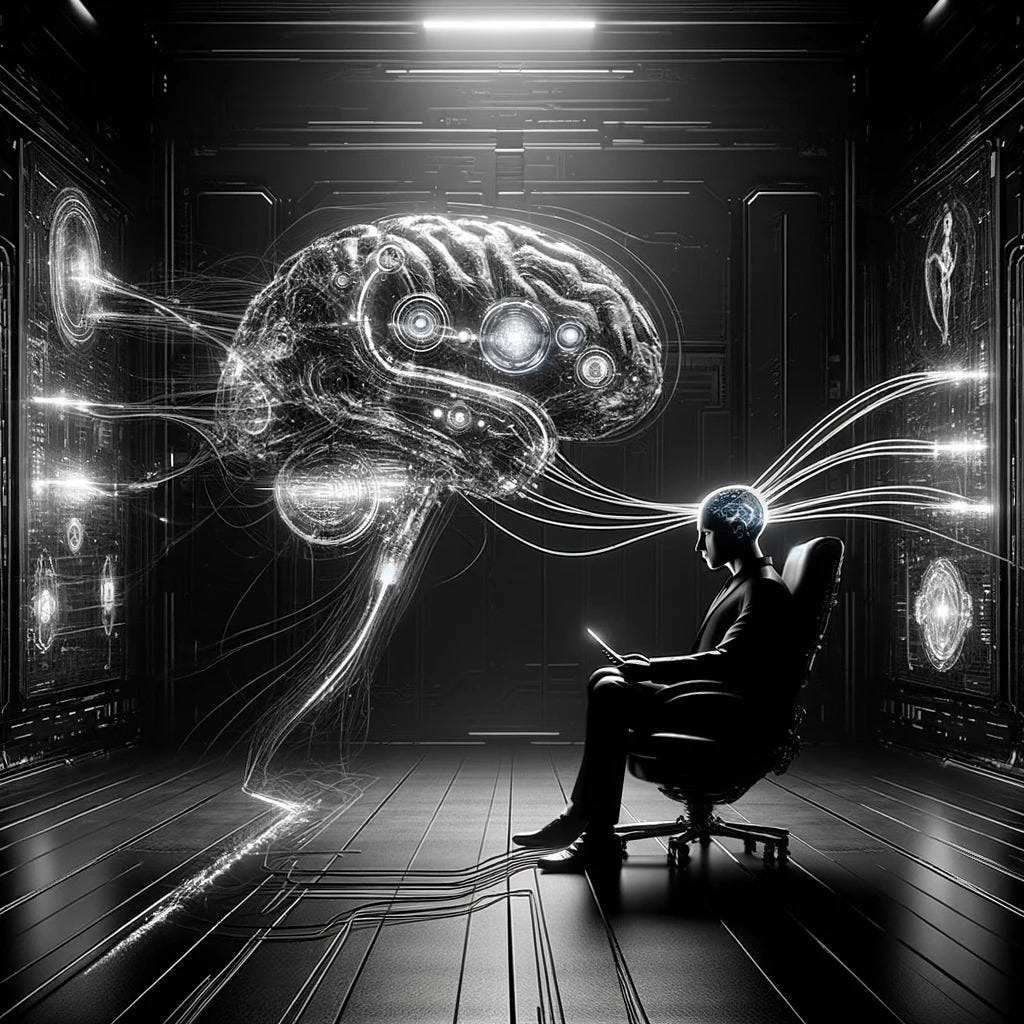Introduction
Diving into the world of human and AI systems merging… is like stepping into the future we've always imagined—where technology not only fits into our hands but becomes a part of us, enhancing everything we do. But as we navigate this exciting terrain of what I call in this post “cyborgism”, there's something super important we need to talk about: ethics and responsibility. It's all about how we use these incredible tools without losing sight of what makes us human. So, let's break it down together, from the tech we carry around every day to the stuff of sci-fi dreams, and make sure we're doing it right.
What is Ethical Cyborgism?
Ethical Cyborgism is the thoughtful integration of advanced technologies, such as AI tools and brain-machine interfaces, into human life, with a steadfast commitment to navigating these enhancements within a framework of ethical responsibility. It's about harnessing the incredible potential of these technologies to augment human capabilities, improve quality of life, and solve complex challenges, while always prioritizing the preservation of our humanity, ensuring equitable access, and maintaining a vigilant stance on the privacy, autonomy, and ethical implications of such integrations. At its core, Ethical Cyborgism champions a future where technology amplifies our human experience without compromising the moral values and principles that define us, advocating for a balanced approach that benefits all of society.
There are levels to Ethical Cyborgism, of which I explain in the following sections.
Level 1: Smartphones and Wearable Technology
Your Everyday Superpowers
Starting with what's already in your pocket, smartphones and wearables are your first step into becoming more than just human. These gadgets are like your sidekicks, making you smarter, and more connected. But as awesome as they are, they come with a catch. It's like having a superpower—you've got to use it wisely.
What to Watch Out For
Privacy Concerns: With the incredible capabilities of our smartphones comes a significant responsibility. These devices hold the keys to our personal lives, from private messages to sensitive data, making privacy a paramount concern. It's crucial to navigate this digital landscape with caution—think of your phone as a vault that contains your most personal secrets. Be judicious about which apps and services you allow access to this vault. Remember, in the digital world, vigilance is your best defense against unwanted intrusions into your privacy.
The Digital Leash: The convenience of smartphones can quickly turn into a digital leash, tethering us to constant notifications and endless scrolling. This connectivity, while often beneficial, can morph into a compulsive need to stay plugged in, overshadowing the importance of real-world interactions and experiences. It's essential to cultivate a relationship with technology where it serves as a tool for enhancement, not a crutch that consumes your attention and time. Setting boundaries, such as designated tech-free times or spaces, can help maintain this balance. For a deeper dive into managing this dynamic, consider exploring discussions on social media addiction, which shed light on navigating our online engagements healthily.
Eroding Social Cohesion: An often-overlooked consequence of our attachment to smart devices is the potential erosion of social cohesion. The irony of increased connectivity is how it can isolate us in bubbles, reducing face-to-face interactions and understanding of differing viewpoints. This digital divide can strain the very fabric of our communities, as virtual interactions replace the nuanced, complex nature of personal connections. Our evolution hasn't prepared us for the rapid shift from communal living to digital isolation, highlighting the need for conscious efforts to reinforce our social bonds. Engaging more in the physical world and fostering real connections are vital steps towards mending the tears in our social fabric and ensuring that technology enriches, rather than divides, our collective human experience.
Level 2: AI Tools for Enhanced Decision Making
Leveling Up With AI
Now, stepping up the game, generative AI tools are like having a wizard by your side. They can crunch numbers, make sense of data, and even spark creativity in ways we never thought possible. Whether it's keeping you healthy or making your work life a breeze, GenAI's got your back. But, as with any powerful magic, there are rules.
Keep These in Mind
Bias Alert: The allure of AI is undeniable—it promises efficiency, precision, and capabilities beyond human limits. However, it's crucial to remember that AI systems are not infallible; they mirror the biases present in their training data, reflecting the prejudices and inequalities of our society. This inherent flaw can lead to skewed decision-making, affecting everything from job applications to judicial rulings. Stay vigilant and critically assess AI outputs, especially when they impact significant life decisions. Encourage the development and use of AI that incorporates diverse datasets and perspectives, aiming for systems that are as unbiased and equitable as possible. Questioning AI's judgment isn't just about skepticism; it's a necessary step in refining these tools to serve us better.
Jobs on the Line: As AI technologies advance, they inevitably reshape the job market, automating tasks that were once exclusively human domains. This transformation sparks a dual narrative: on one hand, it heralds unprecedented efficiency and opens up new avenues for human creativity; on the other, it poses a real threat to traditional jobs, risking displacement and economic uncertainty for many. The challenge here isn't to halt progress but to navigate it thoughtfully. We must champion policies and initiatives that facilitate workforce adaptation through re-skilling and education, ensuring that the workforce evolves alongside technological advancements. Embracing AI's potential means committing to a future where everyone has a place, not just those who can keep up with the pace of change.
Clear as Day: Transparency in AI operations is not just a technical necessity; it's the cornerstone of ethical AI use. Understanding how and why an AI system arrives at a particular decision is critical for trust. Without this clarity, AI becomes a black box—opaque and mysterious, eroding our confidence in its judgments. Demanding transparency is akin to advocating for a map in a foreign land; it empowers us to navigate the AI landscape with informed consent and understanding. Moreover, transparency fosters accountability, ensuring that AI developers and users remain responsible for the outcomes of their technologies. Building a trustworthy relationship with AI, much like any good friendship, is based on openness, mutual respect, and understanding. As we integrate AI more deeply into our lives, let's prioritize clear, comprehensible explanations of its workings, ensuring that this powerful tool remains our ally, not an enigma.
Level 3: Brain-Machine Interfaces (BMI)
The Final Frontier?
Alright, time to talk about something that might sound straight out of a sci-fi movie: brain-machine interfaces (BMIs). Imagine linking your brain directly to a computer—suddenly, your thoughts could control devices, or you could gain senses or abilities you've never had. It's the ultimate blend of human and machine, and it's not as far off as you might think. But with great power comes... well, you know the rest.
Here’s What You Need to Consider
Navigating Your Identity and Autonomy: Embarking on the journey into brain-machine interfaces (BMIs) brings us to a pivotal question of autonomy and identity. As these technologies enable unprecedented integration with our neural circuitry, it's essential to reflect on how this fusion affects our sense of self. Where does the boundary between human essence and machine enhancement lie? In this new era of cyborg capabilities, maintaining a clear sense of identity is more crucial than ever. It's about leveraging technology to enhance our lives without compromising the core of what makes us uniquely human. Always aim to preserve your autonomy, making conscious choices about how deeply you allow technology to integrate into your being. Remember, technology should amplify your true self, not overshadow it.
Ensuring Equitable Access: The advent of BMIs and advanced augmentation technologies presents a significant risk of deepening societal divides. As these technologies advance, there's a real danger that they could become luxuries available only to those with ample resources, exacerbating the inequality between different societal strata. It's imperative to advocate for and actively work towards a future where such technologies are accessible to all, not just the elite. This means supporting policies, initiatives, and innovations that prioritize widespread access and affordability. By democratizing access to augmentation technologies, we can ensure that the benefits of these advancements are shared broadly, helping to close the gap between the "haves" and "have-nots" rather than widening it.
Ethical Integrity Above All: As we venture further into the possibilities offered by technological advancements, ethical integrity becomes our guiding star. The question isn't merely about our capability to push the boundaries of technology but whether we should. Each step forward needs to be taken with a profound sense of responsibility towards the ethical implications of our actions. This approach requires a commitment to ensuring that these technologies are developed and used in ways that respect human dignity, promote well-being, and consider the long-term impacts on society. Ethical integrity in the use of BMIs and other augmentation technologies is not a negotiable aspect of innovation; it's the foundation upon which a just and equitable future must be built. As we embrace these new horizons, let's commit to an ethos of responsible and ethical advancement, ensuring that our technological progress enhances the human experience for everyone.
Ethical Frameworks and Human Responsibility
The Compass
As we navigate through this brave new world with Ethical Cyborgism, we need something to guide us. Ethical frameworks aren't just academic; they're like a compass for this journey. Whether it's utilitarianism (doing the most good for the most people), deontological ethics (following a set of rules or duties), or virtue ethics (focusing on moral character), these ideas can help us make sense of the tough decisions we'll face.
We control the direction of our stories
We're not just passengers on this ride; we're driving it. Our responsibility is to make sure we're heading in a direction that's good for everyone, not just us. That means thinking about the long-term impacts of the tech we develop and use, and making sure it benefits society as a whole. We've got to keep the conversation going—between technologists, ethicists, and everyone else—to ensure the future of Ethical Cyborgism is one we all want to live in.
Conclusion
I could imagine that this post is a lot to take in - the world where Ethical Cyborgism is required is vast and filled with incredible possibilities. But as we stand on the brink of these amazing advancements, remember that our humanity—our ethics, our responsibilities—is what will guide us through. It's about using these powers for good, making sure we bring everyone along for the ride, and never losing sight of what makes us human in the first place.
Let's not be afraid to dream big and push boundaries, but let's also make sure we're doing it right. After all, the future isn't just something that happens to us; it's something we're creating, together. So, let's make it a future we can all be proud of.
If you found this post helpful, consider clicking the share button or explore my posts on mental modeling in the age of generative AI. Additionally, if you are interested in viewing the services I offer, please feel free to browse them here. Also, consider checking out Doc Ligot’s webinars on Generative AI; the link is available here.















